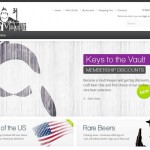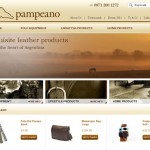One of my regular Digital Marketing clients is going through a bit of a site rebuild at the moment. A big task in this is carrying out a full review of their ecommerce category structure.
 They run an eCommerce site selling very high quality, quite niche merchandise, and in the past they’ve had a very diverse range of products. Recently, though, they’ve started to concentrate on just the high selling products, getting rid of the low-volume bits that are clogging up their eCommerce shop. A good idea, I would say, but it creates a bit of a challenge for the ongoing SEO campaign, mainly in terms of that category and URL structure.
They run an eCommerce site selling very high quality, quite niche merchandise, and in the past they’ve had a very diverse range of products. Recently, though, they’ve started to concentrate on just the high selling products, getting rid of the low-volume bits that are clogging up their eCommerce shop. A good idea, I would say, but it creates a bit of a challenge for the ongoing SEO campaign, mainly in terms of that category and URL structure.
I had a conversation with them today, chatting through the options and what I’m recommending as the way forward, and I thought it would be useful to share with everyone. This is for anyone that wants to improve the category structure in their eCommerce store, and look at improving their category and product pages with respect to SEO. Enjoy!
Setting a Good eCommerce Category Structure
I think the next step is to have a good look at the category structure on the site. This is something that takes a bit of work as changing around categories totally changes the web addresses of each page, and so can play havoc with Google rankings if we’re not careful. To be honest, even if we are careful and I put in all the right re-directs, it’ll likely still have a bit of an effect, but hopefully not too much, and not too negative. And it’s worth it in the long run if it brings the key products to the fore and creates a more sensible, organised and user-friendly category structure.
On how eCommerce categories work with Google – top level categories get the most Google love, and the deeper you bury them, the less authority they tend to carry. This is because the home page tends to have the most authority as it’s, on average, most often linked to. This could lead you to think that you should have a really shallow category structure, every category on the top level…. But, of course, the most important thing is to keep the system easy for the users – the worst thing we can do is to make the site hard to use just for the sake of better SEO.
Currently on your site there are quite a few products which appear in multiple categories. It would be good to cut this down a little. Do you think you would be able to do a bit of brainstorming and come up with, say, 5 or 6 main categories, maximum, and just one layer below that for the important products. If there are less popular products that are worth keeping then you could go to a third layer, but arguably they could be ones to let go.
How to Categorise Your eCommerce Products
I took a while to do some SEO auditing on blue widgets (changed for privacy, obviously!) too, since that’s what you’re trying to push. Category-wise. It’s buried pretty deep, currently 3 layers down on all it’s listings. It’s under:
Sprung Widgets > Men > Blue Widgets
Metal Widgets > Vehicles > Blue Widgets
Summer Widgets > Ladies > Blue Widgets
There would definitely be a small benefit it moving it higher up the tree, to a main category of it’s own perhaps.
Creating a Good eCommerce Category Page
The category page could also use some work – there are currently only a few sentences in the description box. It’s worth putting together at least 200 words or so for that section, putting in a few longer keywords (such as best blue widgets, uk blue widgets, sprung blue widgets, etc) to catch the long-tail if possible. If the description becomes a little long and starts to push the product images too far down, then I could look at splitting it up and having some of it below the products. This would be a good way to include some good, unique content on the category page but not disadvantage the product click-throughs.
Unique Content for your eCommerce Product Pages
On the subject of unique content, it might be worth expanding out the product pages a little too – they’re currently a little light on text. I know it’s hard to come up with unique text for every product but it really does help if there’s a decent chunk of text on each page (say at least 200 words that don’t appear on any other page).
Reviews are great stuff for this – I’ll get on that request you sent through to send each buyer a review request post-purchase (great tip this). It’s a big SEO win if product pages start filling up with relevant, customer created content, and it’s really useful for the customers too, so great stuff for everyone.
I hope that was useful to you and helps you set up your eCommerce shop in a way that really helps both your users and your SEO. If you have any experience in doing this yourself, or want to ask any more questions, please drop them in the comments box below.
Look forward to hearing from you!
colinmcgray
Latest posts by colinmcgray (Posts)
- A Chat About Social Media Marketing - March 27, 2014
- Grow Your Email List: The Best Ways to Create Easy, Effective Opt In Forms - March 11, 2014
- What is Design? Is it a Problem Solving Process, Needing Clear Definitions at the Start? - November 7, 2013
- Getting Your eCommerce Category Structure & Category Pages Right - August 3, 2013
- Time Tracking Tools for Both Online and Offline Work - July 30, 2013

 We are a digital media company who actually listen to you, our customers. We design sites for YOU, that do what YOU need them to do, and what your customers want.
We do Web Design. We do Web Development. We do Ecommerce and we do Internet Marketing. We create an online presence and we make sure people see it. If you want to make your business a success online, get in touch.
We are a digital media company who actually listen to you, our customers. We design sites for YOU, that do what YOU need them to do, and what your customers want.
We do Web Design. We do Web Development. We do Ecommerce and we do Internet Marketing. We create an online presence and we make sure people see it. If you want to make your business a success online, get in touch. 






